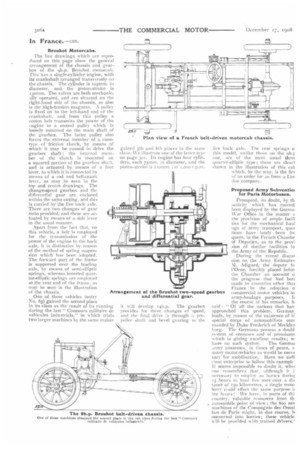Brouhot Motorcabs.
Page 18

If you've noticed an error in this article please click here to report it so we can fix it.
The line drawings which are reproduced on this page show the general arrangement of the chassis and gearbox of the gh.p. Brouhot motorcab. This has a single-cylinder engine, with its crankshaft arranged transversely on the chassis. The cylinder is to5mm. in diameter, and the piston-stroke is i3omin. The valves are both mechanically operated, and are situated on the right-hand side of the chassis, as also is the high-tension magneto. A pulley is fixed on to the left-hand end of the crankshaft, and from this pulley a cotton belt transmits the power of the engine to a second pulley which is loosely mounted on the main shaft of the gearbox. The latter pulley also forms the external member of a conetype of friction clutch, by means of which it may be caused, to drive the gearbox shaft ; the internal member of the clutch is mounted on a squared portion of the gearbox shaft, and is actuated by means of a foot lever, to which it is connected by means of a rod and bell-crank lever, as may be seen in the top and centre drawings. The change-speed gearbox and the differential gear are enclosed within the same casing, and this is carried by the live back axle. There are two changes of gear ratio provided, and these are actuated by means of a side lever in the usual manner.
Apart from the fart that, on this vehicle, a belt is employed for the transmission of the power of the engine to the back axle, it is distinctive by reason of the method of spring suspension which has been adopted. The forward part of the frame is supported over the leading axle, by means of semi-elliptic springs, whereas inverted quarter-elliptic springs are employed at the rear end of the frame, as may be seen in the illustration of the chassis.
. One of these vehicles (entry No. 65) gained the second place in its class as the result of its running during the last " Concours militaire de vehicules industriels," in which trials two larger machines by the same maker
gained 5th and Sth places in the same class. We illustrate one of the latter type on page 301. its engine has four cylinders, each 75mm. in diameter, and the piston-stroke is i mornm. ; at i r000
it will develop lah.p. The gearbox provides for three changes of speed, and the final drive is through a propeller shaft and bevel gearing to the live back axle, The rear springs o this model, unlike those on the 9134 one, are of the more usual thref quarter-elliptic type; these are clearl shown in the illustration of this cak which, by the way, is the firs of an order for 20 from a Lor don company.
Proposed Army Subventio] for .Paris Motorbuses.
Prompted, no doubt, by th activity which has recend been displayed by the Germ& War Office in the matter c the provision of ample facili ties for the mechanical haul age of army transport, ques dons have lately been fre quent, in the French Charnbe of Deputies, as to the provi sion of similar facilities fo the Army of the Republic.
During the recent discus sion on the Army Estimates M. Adigard, the deputy fo l'Orne, forcibly placed befor the Chamber an account o the progress that had bee] made in countries other that France by the adoption commercial motor vehicles fo army-haulage purposes.
the course of his remarks, h said : " Of all the nations that hay approached this problem, German: leads, by reason of the existence of it special corps of automobilists own manded by Duke Frederich of Welder burg,. The Germans possess a doubt. system of censuses and of premiums which is giving excellent results; w have no such system. The Germat army possesses, in times of peace, a many motor-vehicles as would be neces sary for mobilisation. Have we suffi eient enterprise to follow this example It seems impossible to doubt it, whet one remembers that, although it i necessary to till-11)10y 20 horses &rim 15 hours to haul five tons over a die tance of Iso kilometres, a single moto lorry could effect the same purpose it ten hours! We have, in parts of thi country, valuable resources from tit automobile point of view ; the Soo net machines of the Compagnie des Omni bus de Paris might, in due course, h. converted into lorries; these vehicle: will be provided with trained drivers.'






















